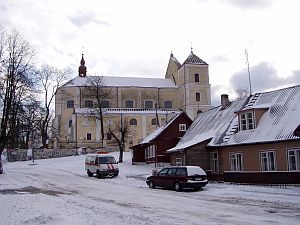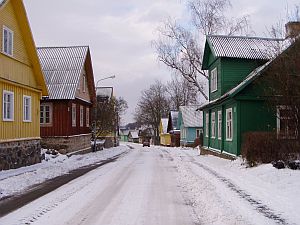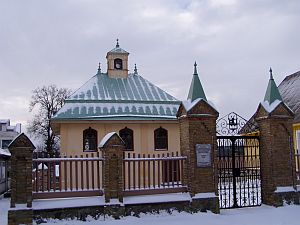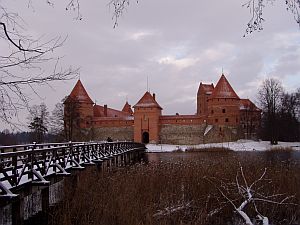Name
Trakai. Not to be confused with the famous Hungarian city of Trokai. Years ago, the town was divided into Nowy Troki (New Trakai) and Stary Troki (Old Trakai). The water castle (here called island castle) and the old picturesque village are both part of the former New Trakai. In historic sources, Trakai is sometimes also referred to as Senieji Trakai.
Location

| ||
| Trakai |
Trakai is only some 30 km away from the capital →Vilnius to the west. It's part of the Vilnius Apskritis (Vilnius district) but center of its own county. Trakai county is some 1,200 km² large - only in this small area there are around 200 Lakes. Additionally, Trakai is the centre of the so-called Trakai Historic National Park - a genuine Lithuanian invention I think.
Population
The small town of Trakai has only around 6,000 inhabitants. Naturally, most of them do not live inside the historic centre but in newer parts of the town. Of those inhabitants, only around 65 people belong the tribe of Karaim - scroll down to read more about them.
Orientation
The town is quite small and easy to navigate, but useful signs are missing at the bus station so it's not that easy to find the right way. Both the train station and the bus terminal lie in the south of town, with the train station being half a kilometer further away from the centre. From the small bus terminal, it's a short walk through a residential area, passing a school and following the road to the north. The main road here is called Vitauti road. To the north, the town is very long but narrow, running all the way along the road. The northern part is sandwiched between the Totoriškių ežeras (Lake Totoriskes) in the west and the long Lukos ež. (Lake Lukas) in the east. After passing a large church it's a few hundred metres further ahead to the remains of an old fortress. That's where Karaimų road starts - a very traditional village with colourful wooden cottages. At the northern tip of the town, two bridges connect the town with the famous water castle of Trakai, which almost entirely occupies a small island in the middle of the 400 ha large Galvė ež. (Lake Galve). It's around 2.5 km between the bus terminal and the castle itself.
History
The history of Trakai most likely started somewhen in the 13th century. The place first became important in the 14th century, when Grand Duke Gediminas (see also →History of Lithuania) decided to build a fortress at Trakai. And so Trakai played an important role in the defeat of the Teutonic Brothers of the Sword. Shortly after that, Gedimina's son even made Trakai the capital of the at that time vast Lithuanian principality. However, later the capital was moved to nearby →Vilnius. The fortress remained and served the aristocracy of the Polish-Lithuanian Union as a secondary residence.
Thanks to extraordinarily liberal rights, many minorities started to settle in the area - among them Russians, Karaim, Tatars just to name but a few. But with the fading influence of Lithuania inside the union, Trakai's star began to wane. During the 16th century, Trakai was eventually degraded to a meaningless provincial town with a dilapidated castle. Things got even worse within the next century when Trakai was looted and destroyed by maroding Russian soldiers. Ever since, the place shouldn't recover - until very recently, when Trakai started to experience its renaissance. Nowadays, many visitors flock to Trakai to see the reconstructed castle and the old village.
Getting there / transportation
There are buses and trains from the capital →Vilnius to Trakai. However, trains do not seem to be very frequent. One to three buses per hour leave the bus terminal of Vilnius for Trakai. The fast, direct buses take around 30 minutes. Many of them continue to Alytus, so that's the destination to look for. A single bus ride costs 2.60 Lt. Slower, regional buses need 45 minutes, the price is the same.
It takes a good deal of time to get away from the bus station and the dull residential area with its grey shops surrounding the station. From the bus stations, two reads lead north towards the old centre of town - a small circular road along the fringe of Trakai and the straight Vitauto road. Halfway there's the tourist information. A few hundred metres further to the north stands the large but not particularly interesting Catholic Church, built during the heyday of Trakai.

| ||
| The old church of Trakai |
From the church its only a few more metres to the north to get to the ruins of the Trakų Pusiasalio Pilis (Trakai Peninsula Castle) on the right-hand side. This castle was built at the end of the 14th century, but large parts of it were completely destroyed. Nowadays, the castle is being restored - in 2004, one tower was always completed and another one almost finished. It looks like Trakai is going to rebuild the entire structure, so by the time you are reading this it might already been finished.
Near the castle, the main street merges into the picturesque Karaimų (Karaim street), where very beautiful old wooden cottages line up. Some of them are in a bad condition, but most of them are still used and look very nice. One of the characteristics of these houses is the structure - no front door, but three windows on the first floor showing towards the street (one for God, one for the family, and one for Grand Duke Vytautas, see below). And vivid colours. All in all a very lovely alley and worth a nice stroll.

| ||
| Trakai: In Karaimų street |
The name of the street mentioned above derives from the Karaimų, also spelled Karay, Karaimu, Karaim or Karaite. Together with the Tatars, these people once came from the → Crimea and finally settled in and around Trakai. At that time, the mighty Lithuanian principality even fought off the Golden Horde in the vast steppe of present-day Southern Ukraine. In order to settle down in the conquered territories, many Tatars and other tribes' members were brought to Lithuania. There, many of them served king Vytautas as guardians. Among them were the Karaites. However, today there are only arond 45,000 Karaites left - with half of them living in present-day →Israel. The Karaites belong the old tribe of the Kipchak, which slowly moved to the west from Mongolia. Karaites believe in the old testament and the Torah but reject the Talmud. This makes them Jews in the eyes of many, but things are different in Israel, where they are considered Goy - non-Jews.
In Lithuania, Karaites form an extremely small community - only 257 Karaites are remaining, with the majority of them living in the capital →Vilnius. Nevertheless Trakai is still considered the Eastern European centre of Karaism. Many Karaites also live in →Istanbul, where they've left their footprints, too: the central district Karaköy is named after the Karaites.

| ||
| Kenesa - the Karaite synagogue |
Karaites are one of many Turkic tribes and so they speak a Turkic language, which has absolutely nothing to do with Indo-European languages such as English. Although the Karaites lived rather isolated for the last 500 years, the Karaite language is an extraordinarily pure Turkic language. But with only 257 Karaites in Lithuania (in 1959: 423), the future of the language is everything but safe. Lithuania has many laws guaranteeing minorities their rights, but unfortunately the Karaite community is probably too small to ensure that Karaite will still be spoken in this country in 100 years or so.
One of the few stone buildings among all the other wooden buildings along Karaimų road is the rather unimposing Kenesa - the Lord's house of the Karaites. Has the word Kenesa the same origin as the Knesset (the House of Parliament) in Israel? I'm not sure about this but it might be true. Of course there's not so much social activity of the Karaites to see anymore in Trakai - with only 65 people left (and I'm sure that they don't want to live like in a zoo) it's less about seeing how this minority lives but more about to see their architecture and a beautiful rural area. For visitors who'd like to know more about the Karaites - there's a Karaite Museum in the middle of the old town.

| ||
| The marvellous island castle of Trakai |
For most visitors the main attraction of Trakai however is the Trakų Salos Pilis (Trakai Island Castle). The castle is only two bridges and an islet away from the northern tip of the older part of Trakai. The red castle occupies almost the entire island in the middle of Galvė ež. (Lake Galve). This mighty water castle was mainly built from bricks and was once the centre of the powerful Lithuanian principality until the late Medieval Ages. But same as the town, the fortress gradually dilapidated after it was ransacked by Russians in the 17th century.
Lithuanian culture was not completely oppressed during Soviet times - as a matter of fact, the Soviet Union took care of many cultural treasures all over the vast country. In 1961, the reconstruction of the castle was initiated - and was about to take not less then 26 years. The result is definitely worth the effort. The structure can be divided into two parts. The western part is a heavily fortified castle with strong outer walls, the eastern part is less fortified and contains a large church. The path between the two parts is flanked by large and impressive walls. Entrance fee to the castle is 8 Lt.
Trakai can be easily done as a day trip from the capital →Vilnius and shouldn't be missed - the castle as well as the above-mentioned beautiful Karaimu-street offer a nice contrast to big cities like the capital and the usual sightseeing involved with that.
There are several pensions and one or two hotels in the historic centre of town - none of them really large. Most visitors do not stay in Trakai but return or go on to the capital - see also →Accommodation in Vilnius).
Particularly in summer, many visitors come to Trakai, and so several restaurants mushroomed in the centre recently. One of them ist the Trys langai, a small and rather cosy restaurant (or a bar with terrace and good food if you want). To get there, walk along the mail road in the old centre - a few metres before the Kenesa you'll see a sign leading you the restaurant. This restaurant mainly serves Lithuanian dishes but also pasta. Service is quite good and a decent lunch costs around 3 to 4 €. There's a local speciality on the menu called Kibinai - small pastries filled with mutton and definitely worth to be recommended.
- www.trakai.lt: Official website of Trakai and its surroundings. English version available and quite useful.
- daugenis.mch.mii.lt/karaimai: English and Lithuanian website of the Karaim Cultural Society.
Do you have or do you know a good website about Trakai? Don't hesitate, let me know! After checking it, I would love to add it to the link list. You can submit a link by using the →contact form. Note that commercial websites will be treated differently.
©2024 Europe-East.com

 Albania
Albania Lithuania
Lithuania